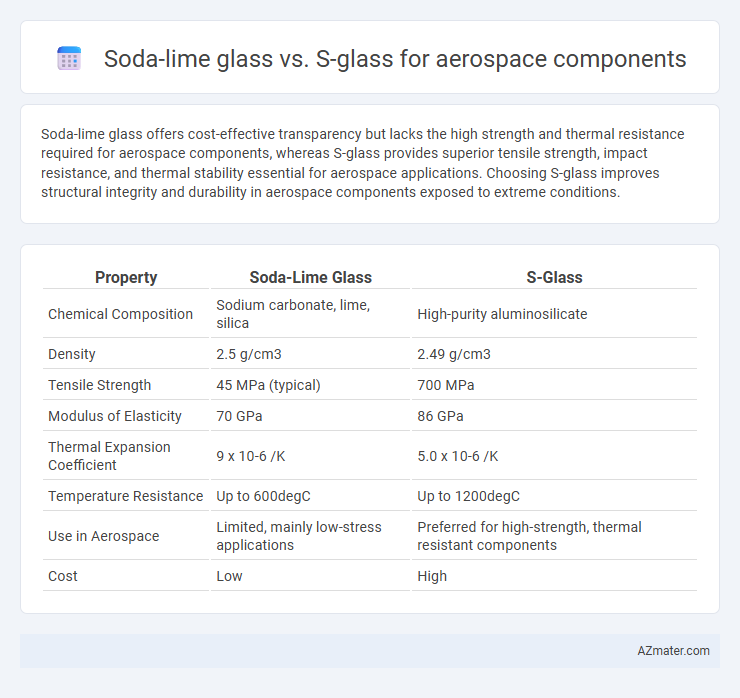Soda-lime glass offers cost-effective transparency but lacks the high strength and thermal resistance required for aerospace components, whereas S-glass provides superior tensile strength, impact resistance, and thermal stability essential for aerospace applications. Choosing S-glass improves structural integrity and durability in aerospace components exposed to extreme conditions.
Table of Comparison
| Property | Soda-Lime Glass | S-Glass |
|---|---|---|
| Chemical Composition | Sodium carbonate, lime, silica | High-purity aluminosilicate |
| Density | 2.5 g/cm3 | 2.49 g/cm3 |
| Tensile Strength | 45 MPa (typical) | 700 MPa |
| Modulus of Elasticity | 70 GPa | 86 GPa |
| Thermal Expansion Coefficient | 9 x 10-6 /K | 5.0 x 10-6 /K |
| Temperature Resistance | Up to 600degC | Up to 1200degC |
| Use in Aerospace | Limited, mainly low-stress applications | Preferred for high-strength, thermal resistant components |
| Cost | Low | High |
Introduction to Aerospace Glass Materials
Soda-lime glass, commonly used for its cost-effectiveness and ease of production, lacks the mechanical strength and thermal resistance required for aerospace applications. S-glass, a high-strength alumino-silicate glass, offers superior tensile properties, higher modulus of elasticity, and improved thermal stability, making it a preferred choice for aerospace components subjected to extreme stresses and temperature variations. The selection of aerospace glass materials prioritizes mechanical performance, durability, and weight reduction to meet stringent safety and efficiency standards in aviation and space exploration.
Overview of Soda-Lime Glass
Soda-lime glass, the most common commercial glass, consists primarily of silica (SiO2), sodium oxide (Na2O), and calcium oxide (CaO), offering cost-effectiveness and ease of manufacture for aerospace applications. It features moderate mechanical strength and thermal resistance, but lacks the high tensile strength and temperature tolerance found in specialized glasses like S-glass. While soda-lime glass is suitable for non-structural aerospace components, advanced composite materials such as S-glass provide superior performance for critical load-bearing aerospace applications.
Understanding S-Glass Composition
S-glass, composed primarily of alumina (Al2O3) and silica (SiO2) with minor amounts of magnesia and lime, offers superior tensile strength and thermal resistance compared to soda-lime glass, making it ideal for aerospace components where durability and heat resistance are critical. Unlike soda-lime glass, which contains higher sodium oxide (Na2O) and calcium oxide (CaO) content resulting in lower mechanical performance, S-glass's intricate composition enhances fiber strength and structural integrity under extreme conditions. This specialized glass type supports applications demanding high fatigue resistance and impact strength, essential for aerospace engineering.
Mechanical Properties Comparison
S-glass offers superior mechanical properties compared to soda-lime glass, including higher tensile strength of approximately 4.8 GPa versus 0.7 GPa and enhanced elasticity with a Young's modulus around 86 GPa compared to 70 GPa for soda-lime glass. The increased fracture toughness and resistance to thermal shock of S-glass make it ideal for aerospace components subjected to high stress and temperature variations. Soda-lime glass, while more cost-effective, lacks the durability and mechanical reliability required for critical aerospace applications.
Thermal Resistance and Stability
S-glass offers superior thermal resistance and stability compared to soda-lime glass, making it ideal for aerospace components exposed to extreme temperature fluctuations. Its higher melting point and enhanced mechanical properties provide better structural integrity and reduced thermal expansion under operational stresses. Soda-lime glass, while cost-effective, lacks the durability and thermal performance required for high-performance aerospace applications.
Weight Considerations in Aerospace Applications
S-glass offers a significantly higher strength-to-weight ratio compared to soda-lime glass, making it more suitable for aerospace components where weight reduction is critical. While soda-lime glass is heavier and less durable under dynamic loads, S-glass provides enhanced tensile strength and improved impact resistance without adding excess weight. This weight efficiency contributes to better fuel economy and overall performance in aerospace applications.
Impact Resistance and Durability
S-glass exhibits significantly higher impact resistance and durability compared to soda-lime glass, making it ideal for aerospace components exposed to extreme stress and environmental conditions. With tensile strength around 4.7 GPa and superior fatigue resistance, S-glass withstands high-impact forces better than soda-lime glass, which typically has lower mechanical strength and brittleness. Enhanced thermal stability and resistance to micro-cracking in S-glass ensure longer component life and improved safety in aerospace applications.
Cost Analysis: Soda-Lime vs S-Glass
Soda-lime glass offers a cost-effective solution for aerospace components due to its low raw material and manufacturing expenses, making it ideal for non-structural parts. In contrast, S-glass, with its superior tensile strength and thermal resistance, commands a higher price reflecting advanced production techniques and specialized materials essential for high-performance aerospace applications. The cost analysis highlights a trade-off where soda-lime glass reduces budget constraints, while S-glass justifies its premium through enhanced durability and performance under extreme conditions.
Typical Aerospace Use Cases
S-glass is preferred for aerospace components requiring high tensile strength and resistance to impact, such as structural airframe parts and radomes, due to its superior mechanical properties compared to soda-lime glass. Soda-lime glass is rarely used in aerospace applications because of its lower strength and thermal resistance but may appear in cockpit windows or non-structural cabin components where cost is a consideration. The exceptional durability and lightweight nature of S-glass make it ideal for critical load-bearing parts exposed to high stress and temperature variations in aerospace environments.
Future Trends in Aerospace Glass Technology
Soda-lime glass, commonly used for low-cost aerospace windows and basic structural components, is gradually being supplanted by advanced materials like S-glass due to its superior tensile strength and thermal stability suited for high-performance aerospace applications. Emerging trends emphasize the integration of S-glass composites with nanotechnology and smart coatings to enhance durability, reduce weight, and improve resistance to extreme environmental conditions in next-generation aircraft and spacecraft. Innovations in aerospace glass technology are poised to leverage hybrid glass systems combining soda-lime and S-glass properties, optimizing cost-efficiency while meeting stringent regulatory and safety standards for future aerospace components.

Infographic: Soda-lime glass vs S-glass for Aerospace component
 azmater.com
azmater.com